Flannery O’Connor’s Why Do the Heathen Rage?: A Behind-the-Scenes Look at a Work in Progress by Jessica Hooten Wilson (Brazos Press, 2024).
The American Catholic novelist Flannery O’Connor was a writer like no other, so it’s fitting that this book—an exploration of her unfinished final novel—is a book like no other. It might better be described as a backstage tour of a book.
English professor and O’Connor scholar Jessica Hooten Wilson (a friend with whom I’ve worked on a couple of previous projects) has collected and edited the fragments of the novel that O’Connor was working on when she died, Why Do the Heathen Rage? Because we unfortunately have so little of that work, Jessica has fleshed out this book with biographical material about O’Connor, as well as a detailed analysis of the novel she was writing—its characters, its influences, and how it reflects both her earlier works and the development of her thinking. She identifies numerous cultural parallels with O’Connor’s story, from Dostoevsky to Psycho and Fight Club. Illustrations to the book are provided by the Southern artist Steve Prince, whose striking linoleum cuts pick up on and illuminate some of the subtlest threads of the story.
O’Connor’s usual themes—primarily the brokenness of humanity and the great need for grace—are present here. And her writing is as sharp and shocking as ever—a baptism that might have been drawn in sentimental colors by other Christian writers is shown here as a teenager being “grasped … and [thrown] … backwards with vicious unexpected strength into the crystal-clear water where a thousand microcosmic suns bounced,” feeling only the preacher’s “unwanted hands gripping him by the arms.” But she was also trying out new ideas regarding structure and characterization, many of them rooted in the social upheavals of her time.
Why Do the Heathen Rage? centers on two characters whose names changed throughout O’Connor’s drafts, but who ended up as Walter Tilman and Oona Gibbs. Walter is one of those feckless young Southern men we see so often in O’Connor’s fiction: intellectual and occasionally incisive, but incapable of any real action and quicker to see others’ faults than to recognize his own. In many ways, Jessica demonstrates, he’s a reworking of the character Asbury in the short story “The Enduring Chill,” who makes himself sick drinking raw milk to show off for his mother’s Black farm hands.
Oona, a social activist from the North, is a woman with a very different nature. O’Connor seems to have gone back and forth over how exactly to portray her, but her character in the handful of pages that we have about her comes across as startlingly vivid and complex, and far less derivative than Walter. I found myself regretting that we never get to see what becomes of her. Though we don’t see her meet Walter, the two characters have maintained a correspondence in which Walter pretends to be a Black man to test Oona’s commitment to social justice—a deception that O’Connor indicates will lead to trouble.
Where was this story headed? We have no way of knowing, but Jessica makes what she calls “a pretentious attempt” to write “one potential ending,” drawn from other unpublished passages that O’Connor wrote, involving a cross-burning. It’s a fascinating thought experiment, but alas, we’ll never know just how close it is to what the novelist intended.
Why couldn’t O’Connor finish her third novel? The simple answer is that she didn’t live long enough—she died of lupus at the early age of 39. But there’s more to it than that. In the early 1960s, O’Connor was starting to grapple with the civil rights movement going on around her. As a white Southerner with a deep Christian faith, O’Connor criticized racism, and yet she often exhibited blind spots of her own on the subject. She could see and deplore the terrible things her fellow whites did in the name of white supremacy, but her vision stopped there—she had little understanding of the other side of the equation, the terrible things that Black people were suffering as a consequence. “O’Connor wants to tell the true story,” Jessica writes, “but, as other writers have pointed out, she was missing an essential part of the story.”
It was O’Connor’s limited vision, Jessica suggests, that hindered her from getting further with her novel, but at the same time gave her the humility she needed to even try to transcend her environment and her views and explore these issues more fully. Again, frustratingly, we can’t know how far she would have gotten. But we can be grateful for what we do have of this intriguing work, and for a guide who understands and interprets its author so well for us.
Book Links:
Flannery O’Connor’s Why Do the Heathen Rage? on Amazon
Flannery O’Connor’s Why Do the Heathen Rage? on Bookshop
(Note: As an Amazon Associate I earn from qualified purchases.)
Goodreads Reviews:
The Wildes by Louis Bayard
The Wharton Plot by Mariah Fredericks
Films for All Seasons by Abby Olcese
The Quiet Damage by Jesselyn Cook
The Bear and the Nightingale by Katherine Arden




Did not know. Looking forward to it! Thanks for the review.